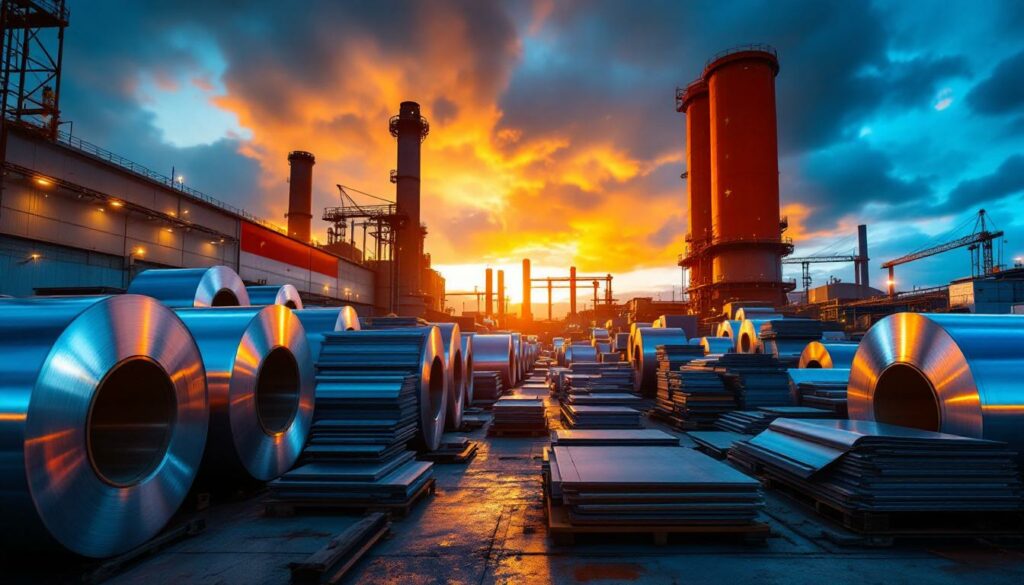What's Happening with China's Steel Exports in 2025?
China's steel export landscape is experiencing a significant transformation in 2025, with overall exports growing despite targeted anti-dumping measures affecting specific product categories. According to recent data from Shanghai Metal Market (SMM), the first five months of 2025 have revealed important shifts in export patterns and product mix that signal broader changes in China's steel industry strategy.
Key Export Statistics for January-May 2025
- Total steel exports reached 48.47 million metric tons, increasing 8.9% year-over-year
- May 2025 exports totaled 10.58 million metric tons, up 1.1% month-over-month
- Sheet and plate exports declined slightly by 0.8% year-over-year to 30.39 million metric tons
This growth comes despite significant headwinds in certain product categories, highlighting the industry's remarkable adaptability in response to changing market conditions and trade barriers.
Key Import Statistics for January-May 2025
- Total steel imports fell to 2.55 million metric tons, down 16.1% year-over-year
- May 2025 imports decreased to 481,000 metric tons, down 7.9% month-over-month
- Sheet and plate imports declined by 16.8% year-over-year to 2.12 million metric tons
The contrasting trends between growing exports and declining imports reflect China's evolving position in the global steel market, with domestic production increasingly serving both local and international demand across diverse product categories.
How Are Anti-Dumping Measures Affecting China's Steel Exports?
Anti-dumping measures implemented by various countries have created significant headwinds for certain Chinese steel products, with particularly severe impacts on hot-rolled coil (HRC) exports. These targeted tariff impact analysis are reshaping China's export portfolio in measurable ways.
Impact on Hot-Rolled Coil Exports
- HRC exports plummeted by 22.1% year-over-year from January to May 2025
- HRC's share of total sheet product exports dropped dramatically from 40% to 31%
- The decline significantly exceeds reductions in other sheet product categories
"The intensified anti-dumping sanctions specifically targeting Chinese HRC have forced manufacturers to pivot toward products with fewer trade restrictions," notes SMM in their June 2025 market analysis.
Factors Behind the HRC Export Decline
- Targeted trade policy: Intensified anti-dumping sanctions specifically targeting Chinese HRC
- Statistical factors: High comparison base from exceptional export volumes in early 2024
- Strategic pivot: Shifting focus toward higher value-added products to avoid trade barriers
- Industry evolution: Strategic industry pivot away from price-based competition in basic products
The data reveals that anti-dumping measures are not uniformly affecting all steel products, but rather creating a selective pressure that is accelerating China's transition toward higher-value steel production and exports.
Which Steel Products Are Gaining Export Market Share?
While basic steel products face export challenges, higher value-added products are showing strong growth, indicating a strategic shift in China's steel export portfolio. This transformation aligns with broader national objectives to move up the manufacturing value chain.
Rising Steel Export Categories
- Plated sheets/strips: Export share increased from 25% to 28%
- Medium-thickness plates: Export share grew from 13% to 15%
- Coated sheets/strips: Export share expanded from 9% to 13%
- Strip steel: Export share doubled from 1% to 2%
These products typically involve more sophisticated manufacturing processes, command higher margins, and face fewer trade restrictions due to their specialized applications.
Declining Steel Export Categories
- Hot-rolled coil: Export share contracted from 40% to 31%
- Cold-rolled sheets: Export share decreased from 10% to 9%
The redistribution of export share from commodity products to specialized materials demonstrates China's steel industry's increasing technical sophistication and market responsiveness.
| Product Category | Jan-May 2024 Share | Jan-May 2025 Share | Change |
|---|---|---|---|
| Hot-rolled coil | 40% | 31% | -9% |
| Plated sheets/strips | 25% | 28% | +3% |
| Medium-thickness plates | 13% | 15% | +2% |
| Coated sheets/strips | 9% | 13% | +4% |
| Cold-rolled sheets | 10% | 9% | -1% |
| Strip steel | 1% | 2% | +1% |
What's Happening with China's Steel Import Market?
China's steel import market is experiencing broad-based declines across most product categories, reflecting both domestic supply sufficiency and changing trade dynamics. This trend further underscores China's evolving position in the global steel ecosystem.
Steepest Import Declines by Product Category
- Coated sheets/strips: Imports fell by 38.3% year-over-year
- Plated sheets/strips: Imports decreased by 24.2% year-over-year
- Hot-rolled coil: Imports declined by 22.5% year-over-year
- Medium-thickness plates: Imports reduced by 18.3% year-over-year
The substantial decline in imports of specialized products like coated and plated sheets indicates that domestic manufacturers are increasingly capable of producing these higher-value items, reducing reliance on foreign suppliers.
Additional Import Trends
- Strip steel, cold-rolled sheets, and electrical steel sheets all showed varying degrees of year-over-year decline
- Overall sheet and plate imports fell by 16.8% to 2.12 million metric tons
This across-the-board import reduction signals China's growing self-sufficiency in steel production across the value spectrum, from basic commodities to specialized products.
How Is China's Steel Export Strategy Evolving?
The data reveals a clear strategic pivot in China's approach to steel exports, moving away from volume-based competition in basic products toward higher-value specialized products. This evolution represents a significant maturation of the industry's global positioning.
Strategic Transformation Indicators
- Product mix shift: Declining share of commodity products like HRC facing trade barriers
- Value chain advancement: Growing proportion of value-added products with specialized applications
- Competitive repositioning: Shift from price-based competition to quality and specialized capabilities
- Trade policy adaptation: Adaptation to increasingly restrictive global trade environment
According to SMM analysis, this transformation reflects "a deliberate strategy to reduce vulnerability to anti-dumping measures while improving profit margins through product specialization" (SMM, June 24, 2025).
Value-Added Product Focus
- Coated and plated sheets showing strongest proportional growth
- Products requiring more sophisticated manufacturing processes gaining share
- Specialized products facing fewer trade restrictions than commodity items
The export data demonstrates that Chinese manufacturers are successfully transitioning from being primarily low-cost producers to becoming providers of increasingly sophisticated steel products that compete on quality and specifications rather than merely on price.
What's the Future Outlook for China's Steel Exports?
The transformation of China's steel export landscape suggests both challenges and opportunities ahead as the industry adapts to changing global trade conditions. Understanding these dynamics is crucial for stakeholders throughout the steel value chain.
Future Challenges
- Trade policy headwinds: Continuing expansion of anti-dumping measures against Chinese steel products
- Market positioning: Increasing global competition in high-value steel segments
- Regulatory environment: Potential for further Trump tariffs global trade restrictions in key export markets
- Production balance: Balancing domestic overcapacity with responsible export practices
Disclaimer: The following section contains forward-looking statements about market conditions and industry trends. These projections are based on current data and analysis but remain subject to significant uncertainty given the volatile nature of global trade policies and economic conditions.
Opportunities for Growth
- Product development: Further development of high-value specialized steel products
- Market diversification: Expansion into emerging markets with fewer trade restrictions
- Manufacturing advancement: Investment in advanced manufacturing capabilities for premium products
- Brand positioning: Potential for "Made in China" steel to compete on quality rather than just price
The industry's ability to navigate these challenges while capitalizing on emerging opportunities will determine the trajectory of China's steel exports in the coming years. The current data suggests that manufacturers are already well into this strategic transition.
FAQ About China's Steel Export Trends
Why are China's HRC exports declining while overall steel exports are growing?
HRC exports are particularly affected by targeted anti-dumping measures in multiple countries, while other steel products face fewer restrictions. Additionally, China's steel industry is strategically shifting toward higher-value products that generate better margins and face fewer trade barriers. The 22.1% decline in HRC exports contrasts sharply with the 8.9% overall export growth, highlighting this selective pressure and strategic response.
How are anti-dumping measures specifically impacting China's steel exports?
Anti-dumping measures typically impose substantial tariffs on specific steel products from China, making them less price-competitive in international markets. These measures have particularly targeted commodity trading focus like HRC, forcing Chinese exporters to pivot toward higher-value products or alternative markets. This explains why HRC's share of sheet product exports has fallen from 40% to 31%, while plated and coated sheets have gained market share.
Which steel products are most resistant to anti-dumping measures?
Higher value-added products like specially coated and plated steel sheets tend to face fewer trade restrictions, as they're often more specialized and less likely to be produced in sufficient quantities by domestic manufacturers in importing countries. This explains why coated sheets/strips have increased their export share from 9% to 13%, while HRC exports have declined significantly.
What does the shift in export product mix mean for China's steel industry?
This shift signals a strategic transformation from competing primarily on price to competing on quality, specialization, and manufacturing capabilities. It represents a maturation of China's steel industry and alignment with the country's broader economic goals of moving up the value chain. The dramatic redistribution of export share from basic products like HRC to specialized materials like coated and plated sheets demonstrates this evolution in concrete terms.
The Transformation of China's Steel Export Strategy
The data from early 2025 clearly demonstrates that China's steel export sector is undergoing a significant transformation. While overall export volumes continue to grow, the composition of these exports is shifting dramatically away from basic products like HRC toward higher value-added products that face fewer trade restrictions.
This evolution reflects both external pressures from anti-dumping measures and a strategic pivot within China's steel industry toward more sophisticated products. The decline in HRC exports by over 22% while overall exports grew by nearly 9% underscores the magnitude of this shift.
As global trade tensions persist, China's steel industry appears to be adapting by focusing on quality over quantity, specialized products over commodities, and value-added manufacturing over basic production. This transformation aligns with broader economic goals of moving up the value chain and competing on capabilities rather than merely on price.
The future of China's steel exports remains uncertain amid evolving US–China trade war policies, but the direction is clear: a gradual shift from being the world's low-cost steel supplier to becoming a source of increasingly sophisticated steel products that can command premium prices in global markets. Furthermore, according to recent analysis from Investopedia, China's steel industry evolution will continue to have ripple effects throughout global supply chains.
The country's pivot toward higher-value steel products also has significant implications for global iron ore trends and raw material pricing as production methods and input requirements evolve. As noted by S&P Global Commodity Insights, these changes in China's export strategy will likely reshape international steel markets for years to come.
Disclaimer: The analysis presented in this article is based on data available as of June 2025 and represents current market conditions. Future developments in trade policy, technology, and global economic conditions may significantly alter these trends.
Ready to Spot the Next Mining Discovery Before the Market Does?
Discover how successful investors consistently beat the market by capitalising on significant ASX mineral discoveries using Discovery Alert's proprietary Discovery IQ model, which provides real-time alerts on major discoveries before the broader market reacts. Understand why historic discoveries generate substantial returns by visiting Discovery Alert's dedicated discoveries page.




